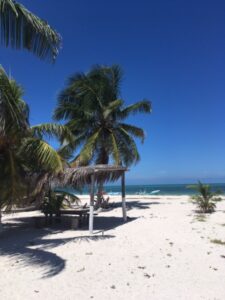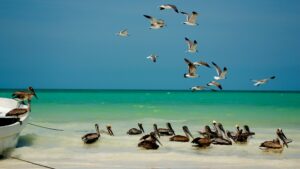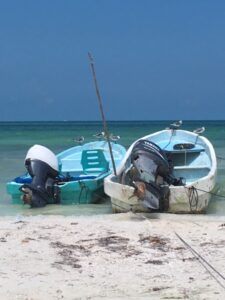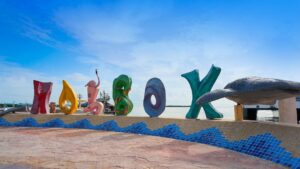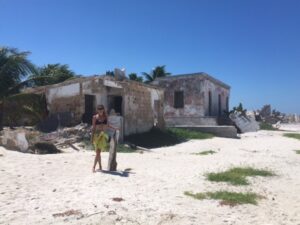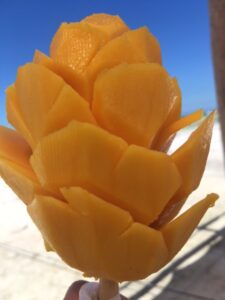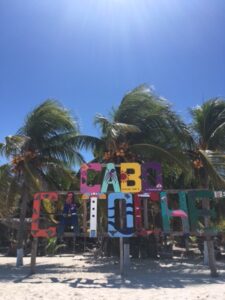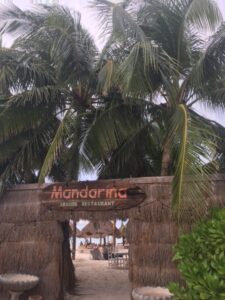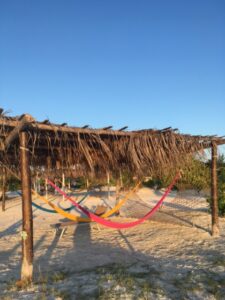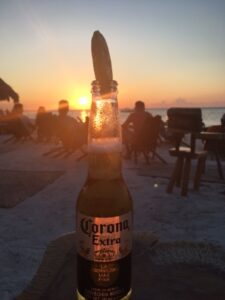Isla Holbox – A Paradise on the Mayan Riviera in Mexico

An island is a cosmos in itself: it is surrounded by water, and the only way to escape it is to board a boat and sail back to the mainland. But why should you do that? Especially when the island is called Holbox, lies off the Maya Riviera on Mexico’s Yucatán Peninsula and has such a strangely unconventional appearance that at first, you’re not sure: Am I in the right place here, or not?
After a 20-hour journey via Zurich (seven-hour layover), I landed at Cancún International Airport on Mexico’s Yucatán Peninsula at 10pm. I had booked a room for the night at the Hotel Oh!Cancun The Urban Oasis in the centre of town. 20 minutes by taxi, tiredness set in. As a welcome, my luggage and I were sprayed with disinfectant spray, the room was friendly and clean.
The Urban Oasis is a mile from the Centro bus station, from which I had booked a shuttle bus to Chiquila for the next day. Ferries leave every half hour from the small port town and take you to the island of Holbox in 30 minutes. In my jet-lagged state, I had forgotten that there was a delicious breakfast at the hotel. The taxi to the bus stop cost five US dollars, the ticket to Chiquila 13. Thank God I had stocked up on dollars, the bank where I wanted to buy Mexican pesos in Munich didn’t have them in stock. ATMs, the bank clerk warned, are rare.
The minibus jolted through dense vegetation for two and a half hours. Every now and then a village appeared, fruit stands at the roadside, huts and traditional cottages in turquoise and pink. Countless people offered guava lemonade. To discourage drivers from speeding, steep speed bumps rise every 20 metres in the local areas, which can be managed at a maximum speed of 5 km/h. The outside temperature climbed to 30 degrees Celsius. In the minibus, the air conditioning rattled and blew ice-cold air into the passenger compartment.
Mexican highlight: Holbox, an island without cars
The harbour town of Chiquila is essentially a handful of ugly concrete shacks, car parks and kiosks where you can buy ferry tickets. 13 dollars, one way. The Isla Holbox appears in the distance. 42 kilometres long, two kilometres wide, about 1500 inhabitants and guests from all over the world. A good three dozen occupied the ferry today. Spanish, French, English and Dutch snippets, anticipation of what was to come.
And that was mud. Yellow mud criss-crossed with ankle-deep puddles which reflected a few diesel-powered golf carts with high tires. There are no paved roads, the paths are made of sand and turn into puddle-strewn tracks during the rainy season. You don’t see normal cars on Holbox, only these golf carts, motorbikes, and three-wheeled trucks. The man with the golf cart wanted 40 US dollars for a one-way trip to the hotel on the beach, which I had booked for 14 days. I waved him off, I was in the mood for some exercise, and booted off with my wheeled suitcase. Two kilometres should be manageable.
I gave up at the next street corner. The wheels were stuck in the mud, my Birkenstock sandals were soaked, sweat was pouring down my face and I waved for a car. Ten minutes of swaying through potholes, past delightful brightly painted little houses, shops and restaurants, the sea emerges. The water shimmered turquoise, the sand was white. Palm trees and blossom trees, fuchsia-colored bougainvillea cascades added up to a postcard idyll. I had booked myself into La Diosa Kali Beach Front Hotel, 14 rooms, a simple house, ten steps from the beach. The room was monastic-simple: bed, sink, shower. But who wants to lie in the room when the beach, sea and tequila were waiting outside? I explored the little town, the beach, and the possibilities of things to do.
10 things to try on Holbox
I’ve intentionally jumbled the recommendations in no particular order. Strict rules and times apply in everyday life, but not in paradise.
- Cabo Catoche
To the left of my hotel on Holbox is a wooden jetty where the boats are tied up for excursions: to Punta Mosquito, to Playa Punto Cocos, to Cabo Catoche where the whale sharks swim or the Holo Negro Yalahau lagoon with an impressive cenote. I booked a trip to the uninhabited island of Cabo Catoche. Six hours, including fishing (the catch was made into a divine ceviche on Cabo Catoche), snorkelling and a selfie in front of a picturesque, dilapidated building. - Massage on the beach
Opposite my hotel is a bamboo hut with a roof of palm fronds. In front of it is an area with a sun awning and deck chairs that you can rent for the day. This was my place-to-go, the internet was unreliable, I had a book with me “A Story of Love and Darkness” by Amos Oz, 830 pages, the 14 days were just enough. Indispensable was the full body massage in the shelter of Carlos’ bamboo hut, which left me as deeply relaxed and supple as a gummy bear. - Afternoon snack and fine dining under palm trees at the Amaité Beach Hotel
The setting is spectacular: a few tables and chairs on white sand, palm trees providing shade and a view of an impressive piece of street art, of which there is quite a bit to see in Holbox: Here a concrete wall in the water on which a fisherman can be seen in the water. The guacamole is highly recommended, accompanied by a lime lemonade with fresh mint. In the evening, there is fine dining with fresh lobster on the jetty and live music. - Coffee in the morning at seven o’clock
Hotels on Holbox do not serve breakfast before eight o’clock. If you are awake earlier because of jet lag, there is a way to banish fatigue with a good coffee: The tiny Dunosusa supermarket opens at seven in the morning and sells a cup of coffee for the equivalent of 1.30 euros. Take it to the still empty beach and start the day leisurely. - Renting a bike
The easiest way to get around is by bike. You can rent one of the golf carts too, but you run the risk of getting stuck in the deep potholes. The comfortable cruiser bikes take you everywhere, and they are also allowed on the beach. - Empanadas on the beach
Flying vendors offer the spicy Argentinian dumplings all day long. My favorite vendor was called Bruno and was a handsome young man from Buenos Aires who financed a trip around the world by selling empanadas. You drink fresh coconut milk with it and have a sweet golden mango popsicle style for dessert – you don’t need a Michelin restaurant here. - Corona beer and dancing at sunset
It’s a ten-minute walk along the beach from the central jetty to La playa de Ñaña bar. Be careful, there are trip hazards, the fishing boats on the sea are moored with long ropes on pegs in the sand, hammered far into the beach! Happy hour can be taken literally at La playa de Ñaña: Danceable techno music, comfortable chairs, feet in the sand, an ice-cold Corona beer and the psychedelic light show of the sunset are pure happiness. When it gets dark, the bar closes. A few steps away, another one is open, the Beach Bar Cariocas, for example, beckons with live music and dancing until sunrise. - Authetic Japanese kitchen
Ceviche, guacamole, pizza, bowls – the culinary offer on Holbox is varied and of high quality. But the authentic Japanese cuisine in the front garden of the Diosa Kali Hotel is unique. From 6 p.m., the sandy area is transformed from a chill-out spot with hammocks between palm trees into the Hinata restaurant, run by the young Japanese chef Hiruito. Top dishes: the fire pot dish sukiyaki, freshly grilled yakitori, or the curry stew with vegetables. Wine is not served, but sake or – not quite in style – a Cerveza Tecate. - Chilaquiles rojos for breakfast
Anyone can prepare an omelette. Yes, even the chefs at Restaurant Naranjas on Calle Namero. But much better is a chilaquiles rojo, a hearty dish of tortilla, a tomato-based salsa with chillies, garlic, onions, coriander, and a fried egg. Queso blanco, a simple, dehydrated cow’s milk cheese, is grated on top. Keeps you happy until the first empanada on the beach. - Flirt with the boys at the Bikini Bottom Bar
The Bikini Bottom Bar near the central boat landing is a construction of rough wooden boards, the roof is made of dried palm fronds, the chairs in the sand don’t fit together and yet: it’s my favourite bar. The playlist puts you in a good mood, just like the two bartenders Limberth (a Mexican first name) and Oscar. The mojito is so strong that after one you are already tipsy, and the tropical starry sky takes on a new galactic dimension. Salud!

My curriculum vitae is as colorful as the world. I was editor at ELLE, tested cars and participated at off-road tours. I lived on a small island in Florida for twelve years and from there I travelled the Caribbean and almost all states of the USA for various magazines, conducted interviews with interesting people, reported on beautiful homes and exotic travel destinations. After my return to Germany I worked for InStyle magazine for 14 years in various positions. And it was there that I first came into contact with the topic of beauty. To this day I still enjoy immersing myself in the fine cosmos of creams, perfumes and lipsticks. (photo: Thomas Dilge)
